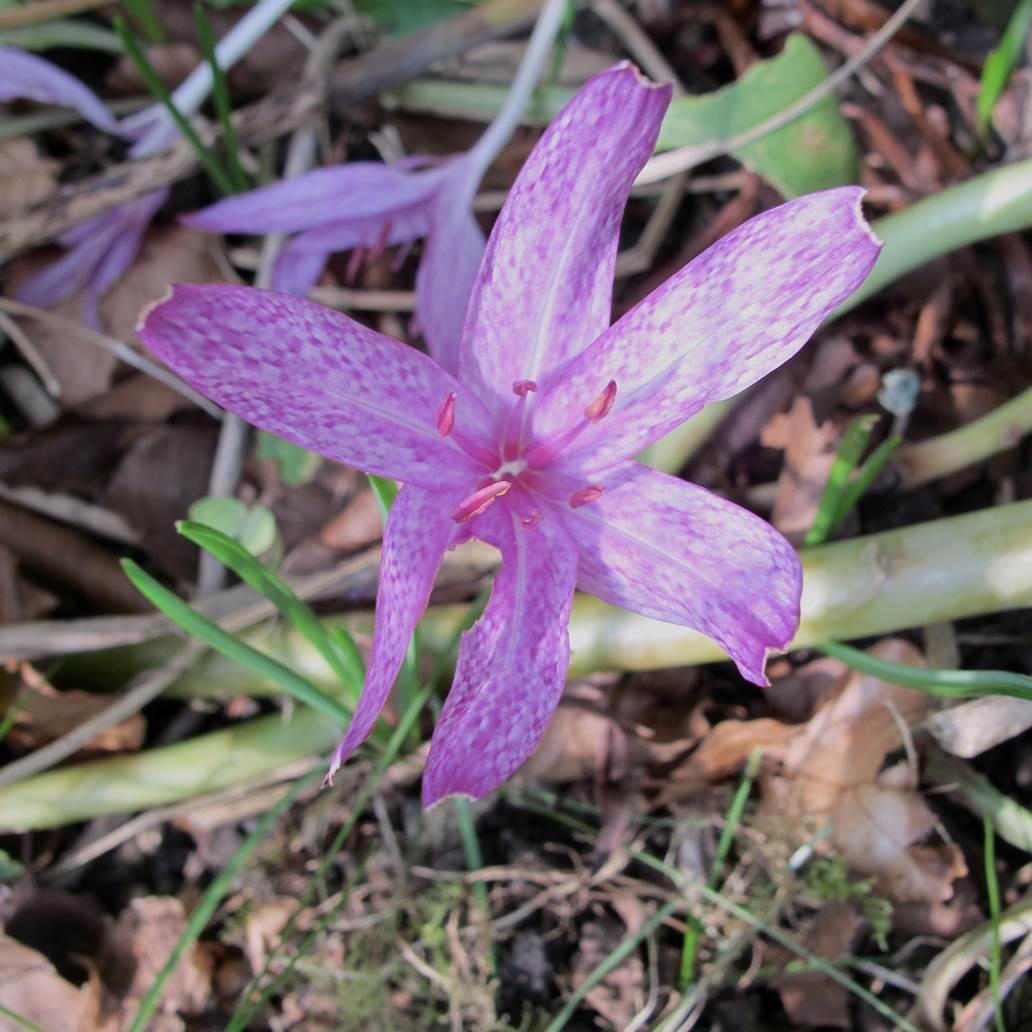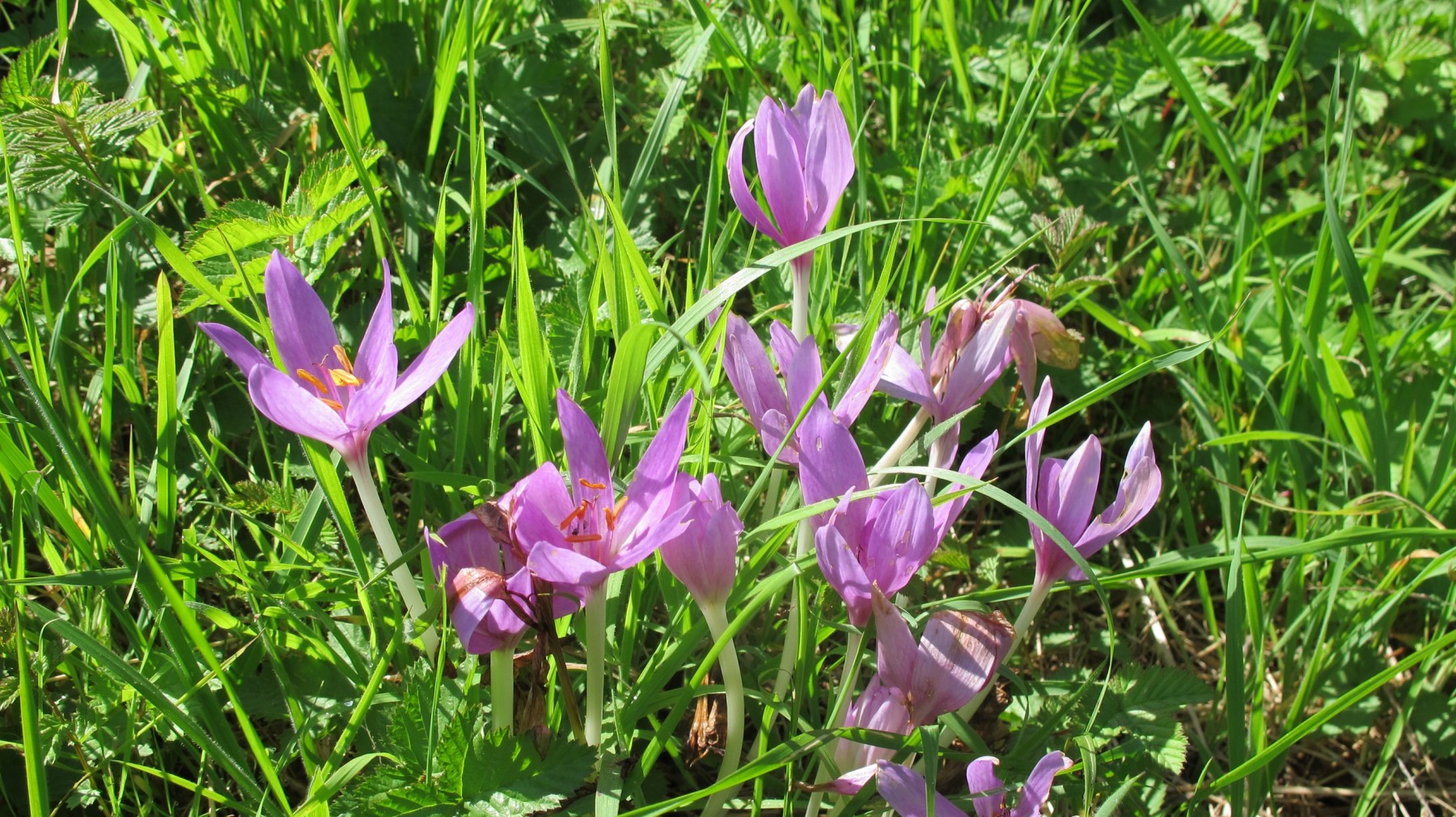
There are certain plants that announce the beginning of a new era as effectively as a clock striking midnight at Prince Charming’s ball. The first rose of summer for instance, or the parchment of a silver birch trunk glistening in low winter sun. When autumn is on the horizon there are two that pop up unannounced – Cyclamen hederifolium and Colchicum or autumn crocus. Their presence lets you know, with a real touch of sadness when the summer’s been as samp and drear as this one has, that summer is no more. This year the clock seems to be striking a little earlier than usual because my first colchicum, ‘Nancy Lancaster’, was out before September.
Nancy is always my earliest colchicum and I squeeze about twenty or more different ones in quieter corners of the garden, or round fruit trees. They need a quiet corner, rather like a naughty child, because they are Jekyll and Hyde characters. Their soft-petalled flowers are as graceful and swooning as any young ballerina and a large colchicum can produce up to twenty Naked Ladies as the flowers are often called – a succession of delights. However their large leaves can only be described as wrinkled old hags but, as the old saying goes, you can’t have one without the other. Those leaves appear in early spring, and they will smother any miniature spring-flowering bulbs, so they are not suitable for a spring garden full of small treasures. And it gets worse: as spring wanes the foliage begins to brown and die horribly, lingering and withering until midsummer. And it’s amazing how this toxic plant seems attract snails and slugs to its flagging mess of leaves.
Colchicum is poisonous to animals, so cattle and dairy farmers tended to eradicate our native, C. autumnale, from the water meadows and low pastures of western England. However it’s been a medicinal plant for centuries and the ancient Greeks and Arabs used it to cure aches and pains and the seeds and bulbs were used to make the extremely bitter Tinctura Colchici, one of the great plant remedies. It was thought to ease rheumatism and it’s still used to treat gout because the chemical colchicine breaks down uric acid crystals. Crops of colchicums were once grown in Oxfordshire and Gloucestershire for medicinal purposes and there are still wild colonies. One, on the road between Chipping Norton and Hook Norton, is still prolific. Colchicine is also used in plant breeding, to alter the chromosome count of monocots such as irises and hemerocallis.
Their name refers to Colchis, an ancient kingdom which used to be found between Armenia and the Caucasus, and this is the area where many of these members of the lily family grow. In all there are around sixty species in West Asia, areas around the Mediterranean and in Europe. They produce bulbs and these can be bought in autumn, although the best time to divide them in the garden is late summer. Ideally this should be done every three or four years. Like all bulbous plants they need good drainage, but they also like some moisture. Mine seem happy to flower in the furthest outposts in shade – although this makes them later.
One virtue of ‘Nancy Lancaster’ is the small size of her leaves so seek her out first, along with the chequered C. agrippinum. This more diminutive colchicum, thought to a hybrid between C. variegatum and C. autumnale, has never been found in the wild and is probably a garden hybrid. The starry mauve flowers are chequered and tessellated, rather similar to the markings of a snake’s head fritillary (Fritillaria meleagris). The narrow foliage is well-behaved for a colchicum and it will grow in refined grass and it always popped up in the alpine meadows at RHS Wisley in profusion and probably still does. You’ll get a succession of fifteen flowers per bulb in a sunny position.
Other mauve-tinted varieties include C. byzantinum and C. cilicicum. The latter has a strong neck and a good scent and normally flowers in September and October. C. byzantinum has narrow petals that should have a stripe running down the middle of the petals. The stamens are red-orange, but this very vigorous plant ( possibly with hybrid C.cilicicum blood) needs space for its huge ribbed foliage.
Named hybrids tend to be larger flowered and often pink. ‘Rosy Dawn’, raised by Barr & Sons , has flowers that open wide to reveal a white middle and yellow stamens. ‘Pink Goblet’ was selected by Dick Trotter and there is also a violet-pink colchicum named after Dick Trotter. It’s being produced in bulk by the Dutch so grab it if you can. ‘The Giant’ is a late, large flowered pink with lots of white inside. I also rate ‘E.A Bowles’ a deep aster-violet colchicum of great stature.

The best two late colchicums are very distinctive and deserve to be grown. ‘Waterlily’ is a showy, multi-petalled mid-pink variety with strap like petals that tend to flop on the ground – although this can look good on a still dank autumn day. The flowers are so welcome in late-September and October when the garden is beginning to fade into decadence. It was raised in 1905 by the Dutch nursery Zocher and Co, along with several colchicums, and it’s one of the best to bulk up, so widely available.
The best colchicum of all flowers last – C. speciosum ‘Album’. It produces a pure-white goblet on a strong tube and often appears in October and it should not be confused with the white from of our native, C. autumnale ‘Alba’. Its dirty flowers give rise to the name dirty bones in the bulb trade. C. speciosum ‘Alba’, which has substantial flowers in pure-white, was selected by Backhouse of York at the end of the 19th century bulbs. Back then one bulb fetched five guineas each according to E.A Bowles writing in “A Handbook of Crocus and Colchicum” published in 1924. Bowles grew a huge range and in his day they were highly popular. Now the bulb companies can hardly give them away, so if you have a quiet corner do plant some. Pottertons Nursery have some good varieties at excellent prices by mail order. tel 01472 851714/ pottertons.co.uk.



